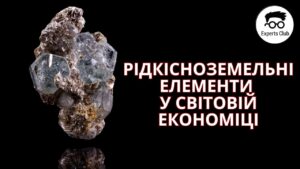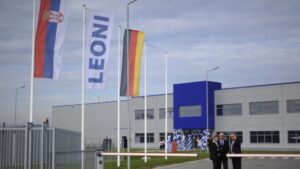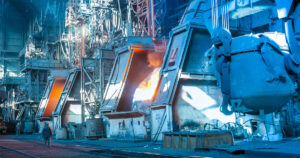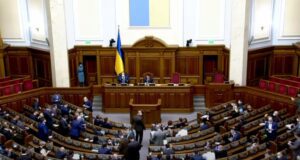
On May 8, 2025, the Verkhovna Rada of Ukraine ratified a strategic agreement with the United States of America on the joint use of mineral resources, which was an important step in strengthening the economic partnership between the two countries. The agreement provides for the creation of a Joint Reconstruction Investment Fund, which will give the US priority access to Ukrainian minerals, including lithium, titanium, graphite, and uranium. At the same time, Ukraine expects increased military support and economic stability.
Volodymyr Khaustov, scientific secretary of the State Institution “Institute of Economics and Forecasting of the National Academy of Sciences of Ukraine,” honored economist of Ukraine, and candidate of technical sciences, shared his vision for the prospects of this agreement in a video from the Experts Club expert and analytical center.
“Ukraine has significant potential in the field of strategic mineral extraction. However, it should be understood that realizing this potential requires significant investment and time. Many deposits, particularly lithium deposits, are located in regions where infrastructure needs to be modernized and geological data is based on outdated Soviet research,” Khaustov said.
The expert also highlighted the technological challenges associated with the extraction and processing of Ukrainian minerals.
“Most lithium deposits in Ukraine contain ores that are difficult to enrich using existing technologies. This requires the development of new processing methods, which in turn requires time and financial resources,” he explained.
The agreement also stipulates that profits from joint projects will be reinvested in Ukraine during the first ten years, which should contribute to the country’s economic recovery. However, Khaustov warns against excessive optimism about quick results.
“The implementation of such large-scale projects is not a matter of one year. All risks and challenges, including geopolitical and economic ones, that may affect the implementation of the agreement must be taken into account,” he stressed.
Overall, the expert believes that the signing of the agreement with the US is an important step for Ukraine, opening up new opportunities for the development of the mining industry and strengthening the economy. However, the successful implementation of the agreements requires a comprehensive approach, strategic planning, and close cooperation between all interested parties.
“This is a chance for Ukraine to become an important player in the global market for strategic minerals. But this requires not only desire, but also real action, investment, and technological solutions,” Volodymyr Khaustov concluded.
Thus, the agreement between Ukraine and the US opens a new page in the economic partnership between the two countries, but its successful implementation depends on many factors that require careful analysis and balanced decisions.
You can learn more about Ukraine’s mineral resources in the video: https://www.youtube.com/watch?v=IFI5sUBX3gc&t
You can subscribe to the Experts Club channel at: https://www.youtube.com/@ExpertsClub

Experts Club has published a study on the dynamics of industrial production in Croatia and its trends in recent years. In the beginning of 2025, industrial production in Croatia shows moderate growth, despite fluctuations in previous months. According to the Croatian Bureau of Statistics, industrial production increased by 5.4% in February 2025 compared to the same period of the previous year. This is a slowdown compared to January 2025, when growth was 7.6%.
The following industries recorded the highest growth in February 2025.
At the same time, consumer goods production declined:
Monthly trends
Compared to January 2025, industrial production fell 3.9% in February. This is the first decline in the last three months, indicating instability in the industrial sector.
Historical dynamics of industrial production (2000-2024)
Below are the dynamics of industrial production in Croatia for the period from 2000 to 2024:
These data reflect fluctuations in Croatia’s industrial production over the last 25 years, with periods of both growth and decline.

Experts Club Information and Analytical Center has analyzed the dynamics of industrial production in Serbia and its growth trends in Serbia in recent years. At the beginning of 2025, industrial production in Serbia shows a slowdown in growth compared to the previous year. According to Trading Economics, in January 2025, industrial production increased by 0.4% in annualized terms, but in February it recorded a decrease of 1.8% compared to the same period in 2024.
In 2024, industrial production in Serbia showed positive dynamics. In December 2024, growth amounted to 2.7% in annual terms, which was the result of a 9.9% increase in production in the extractive industry and a 5.6% increase in manufacturing.
In order to understand the current trends, let us look at the changes in industrial production in Serbia in recent years, based on the analysis of data collected by the Experts Club for the period from 2000 to 2024.

2000: growth by 10.2%
2001: growth by 1.5%
2002: growth by 1.7%
2003: 3.5% growth
2004: 7.1% growth
2005: 0.8% growth
2006: 4.7% growth
2007: 4.9% growth
2008: increase of 1.1%
2009: decrease of 12.1%
2010: increase of 2.5%
2011: increase of 2.1%
2012: decrease of 1.5%
2013: increase of 5.5%
2014: decrease of 6.5%
2015: increase of 8.3%
2016: growth of 4.7%
2017: increase of 3.9%
2018: growth of 1.3%
2019: increase of 0.3%
2020: decrease of 1.0%
2021: increase of 6.0%
2022: increase of 1.9%
2023: increase of 5.8%
2024: 3.1% growth
The data reflect fluctuations in Serbia’s industrial production over the last 25 years, with periods of both growth and decline. For the last 4 years, industrial production in Serbia has been growing steadily.

Industrial production in Ukraine in June this year decreased by 0.3% against June last year and by 6.2% against May this year, the State Statistics Service (Gosstat) said in a statement.
According to its data, as a result, the growth of industrial production at the end of the first half of 2024 compared to the same period last year slowed to 8.1% from 9.9% at the end of five months.
It is pointed out that the decline in production in June was due to a drop in the supply of electricity, gas, steam and conditioned air, down 11.2%, while the processing industry recorded an increase of 0.6% and mining and quarrying 1.4%.
It is specified that the increase in production in June 2024 to June 2023 was recorded in metallurgy – by 34%, in mining and quarrying – by 1.4% due to growth in the extraction of metal ores – by 30.1%, in the production of coke and petroleum refining products – by 3.2%.
In general, for the first half of 2024 industrial production in Ukraine increased in the processing industry – by 11%, in mining and quarrying – by 9.3%, in the supply of electricity, gas, steam and conditioned air – by 1.5%.
The Stat Department points out that the volume of industrial products sold in January-June this year reached 1707.9 billion UAH, of which outside the country – 351.7 billion UAH.
The State Statistics Committee reminded that in May this year there was a growth of 3.6% compared to May last year, in April – by 11.6%%, in March – by 5%.
According to revised data of the State Statistics Committee, industrial production in Ukraine in 2023 increased by 6.8%, while in 2022 the decline amounted to 36.7%.

Ukraine in 2022 sold industrial products (goods, services) worth 2.814 trillion UAH, which is 21.5% less than in 2021 (3.584 trillion UAH), including outside the country – on 564.097 billion UAH, the State Statistics Service said on Friday.
According to her data, in December 2022 compared to December 2021, the turnover of products sold in the extractive and processing industries decreased by 38.1%. Sales of the extractive industry in December-2022 compared to December-2021 decreased by 40.2%, processing industry – by 37.7%.
Sales in the extractive industry in December-2022 compared to November-2022 increased by 7.8%, in the processing industry – by 5.0%.
In total sales of industrial products in 2022 the largest share came from processing industry (53.6%), supply of electricity, gas, steam and air conditioning (31.1%), mining and quarrying (14.1%), metallurgical production (8.6%).
As reported, Ukraine in 2021 sold industrial products (goods, services) in the amount of 3.584 trillion UAH.

The Parliamentary Committee on Finance, Tax and Customs Policy on Tuesday recommended that draft laws No. 8298 and No. 8299, which exempt the import of equipment and components for own production from VAT and duties until the end of martial law (MP), be passed as a basis, the committee head Daniil Hetmantsev said in a telegram.
“The Ministry of Finance did not support almost the entire law … During the committee noted that without the agreement of the IMF this bill will not be adopted. Negotiations with the IMF on this law have not yet been held,” the deputy head of the committee Yaroslav Zheleznyak indicated in Telegram.
As specified Getmantsev, the bills also include preferential rent for iron ore and water for the period of the EaP, as well as single tax benefits for the taxpayers of Group 4.
In addition, it is planned to extend the life of the registered EDR, which had such a term expired during the EaP, as well as the abolition of taxation for electronic stamps and digital postage stamp and services for the demonstration and demonstration of films with Ukrainian dubbing.
“My prediction is that we will never accept it as a whole in this volume, precisely because of the IMF position,” Zheleznyak said.